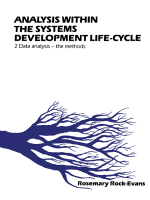Browse content
Table of contents
Actions for selected chapters
- Full text access
- Book chapterAbstract only
Chapter 1 - Introduction
Pages 1-9 - Book chapterAbstract only
Chapter 2 - Preparation
Pages 11-42 - Book chapterAbstract only
Chapter 3 - Collection
Pages 43-81 - Book chapterAbstract only
Chapter 4 - Synthesis (inductive logic)
Pages 83-212 - Book chapterAbstract only
Chapter 5 - Verification
Pages 213-230 - Book chapterAbstract only
Chapter 6 - Approval
Pages 231-242 - Book chapterAbstract only
Chapter 7 - Summary
Pages 243-266 - Book chapterNo access
Glossary and acronyms
Pages 267-277 - Book chapterNo access
Index
Pages 279-287
About the book
Description
Analysis within the Systems Development Life-Cycle: Book 2, Data Analysis—The Methods describes the methods for carrying out data analysis within the systems development life-cycle and demonstrates how the results of fact gathering can be used to produce and verify the analysis deliverables. A number of alternative methods of analysis other than normalization are suggested. Comprised of seven chapters, this book shows the tasks to be carried out in the logical order of progression—preparation, collection, analysis of the existing system (which comprises the tasks of synthesis, verification, and approval)—and in each case how the input from the previous task is converted to the output for the next task until the final output—the verified approved deliverables—is obtained. The first chapter puts analysis into its place in the Systems Development Cycle (SDC) and explains what analysis really means. The next chapters cover, in logical sequence of dependency, the actual tasks of data analysis. The advantages and disadvantages of each method are described in the context of the life-cycle as a whole and in terms of the reliability of raw input, time problems, and so on. Each of the data models obtained using the different methods can be combined and subsequently refined using a number of step-by-step checks. The final chapter shows how the meta-model can be expanded by considering the intermediate outputs of the tasks of data analysis. This text will be of interest to systems analysts and designers and those who are involved in expert systems.
Analysis within the Systems Development Life-Cycle: Book 2, Data Analysis—The Methods describes the methods for carrying out data analysis within the systems development life-cycle and demonstrates how the results of fact gathering can be used to produce and verify the analysis deliverables. A number of alternative methods of analysis other than normalization are suggested. Comprised of seven chapters, this book shows the tasks to be carried out in the logical order of progression—preparation, collection, analysis of the existing system (which comprises the tasks of synthesis, verification, and approval)—and in each case how the input from the previous task is converted to the output for the next task until the final output—the verified approved deliverables—is obtained. The first chapter puts analysis into its place in the Systems Development Cycle (SDC) and explains what analysis really means. The next chapters cover, in logical sequence of dependency, the actual tasks of data analysis. The advantages and disadvantages of each method are described in the context of the life-cycle as a whole and in terms of the reliability of raw input, time problems, and so on. Each of the data models obtained using the different methods can be combined and subsequently refined using a number of step-by-step checks. The final chapter shows how the meta-model can be expanded by considering the intermediate outputs of the tasks of data analysis. This text will be of interest to systems analysts and designers and those who are involved in expert systems.
Details
ISBN
978-0-08-034101-9
Language
English
Published
1987
Copyright
Copyright © 1987 Elsevier Ltd. All rights reserved.
Imprint
Pergamon
